From the tallest mountain peaks to the immeasurable caverns of the deep sea, Earth’s extraordinary animals survive and thrive, even in the most unforgiving environments. Some creatures have even adapted to live both on land and in water. Let’s explore some of the most fascinating animals that roam land and sea and discover their unique adaptations!
1. Mudskipper (OxudercinaeI)
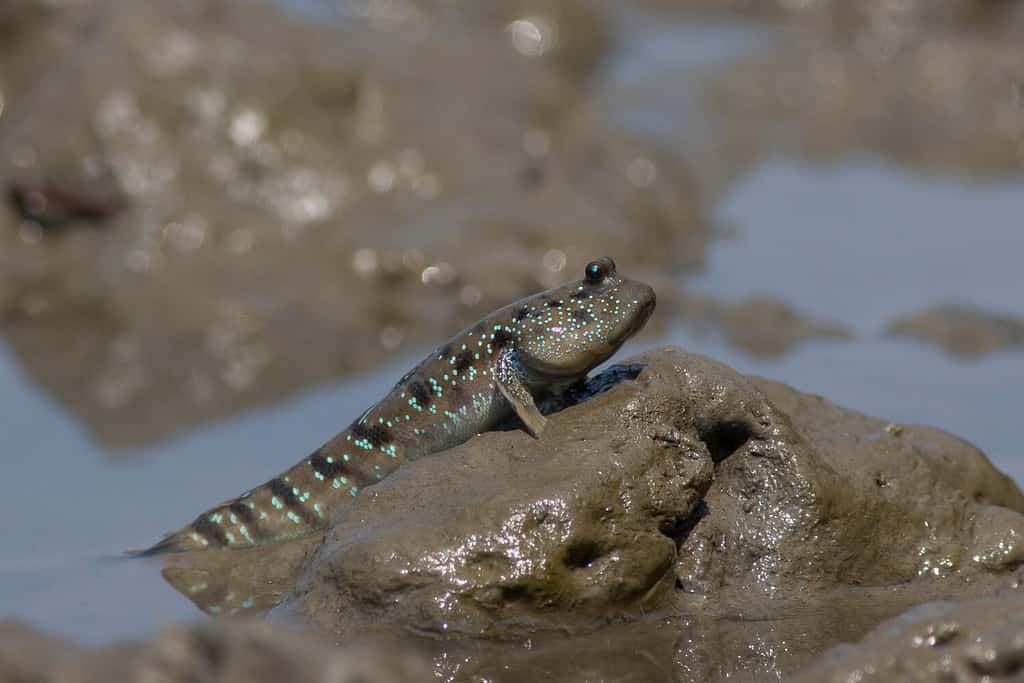
Mudskippers dig muddy burrows with their mouths, which provide oxygen, moistern and protection while on land.
©aDam Wildlife/Shutterstock.com
Commonly known as the “fish that can walk”, the mudskipper is an unusual animal that lives both on land and in water. Several species of mudskippers live in Australia, Africa, and Asia. They spend at least half of their lives out of the water, but their bodies need to remain wet and moist to survive. Mudskippers breathe oxygen through their skin (cutaneous breathing) and use gills to collect and save water for later. They also have large fins that help them crawl up trees, rocks, and mangrove roots.
2. Marine Iguana (Amblyrhynchus cristatus)

Marine iguanas can dive down as deep as 65 feet underwater.
©Danita Delimont/Shutterstock.com
This exceptional reptile is so unique that you’ll only find it on the Galápagos Islands. Although they are mainly land animals, marine iguanas hunt for food in the sea and enjoy munching on marine algae. They are incredible swimmers and use their flat tails as propellors. When grazing along the ocean floor, they use their sharp claws to keep their bodies anchored in the water. Marine iguanas are the only lizards in the world that live part of their life in the water and have specialized nasal glands that allow them to “sneeze out” salt from their blood!
3. Frigatebird
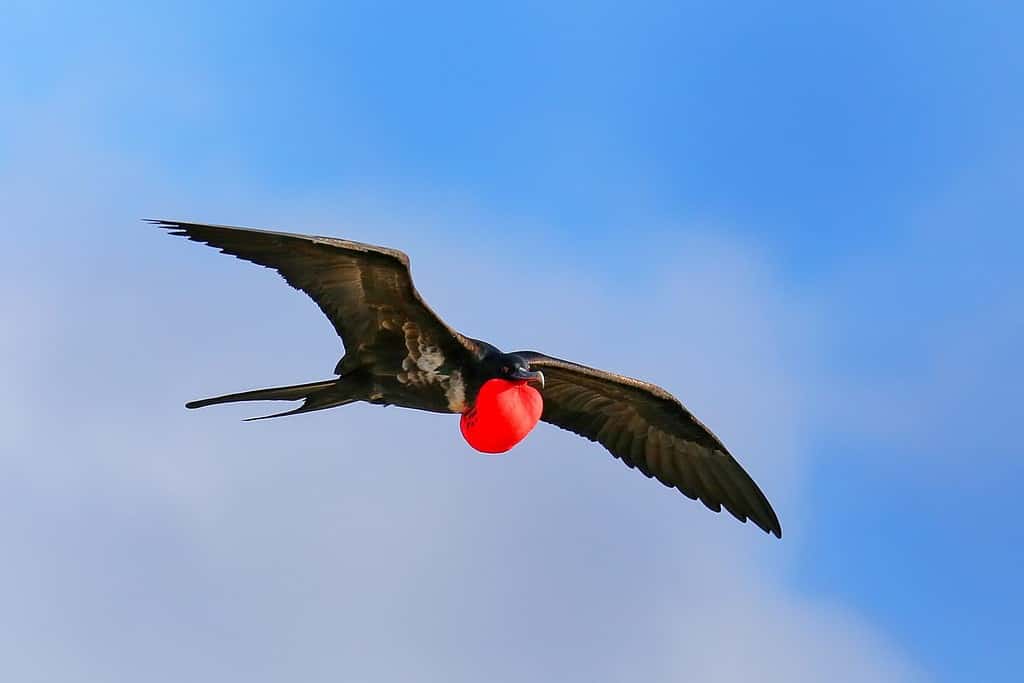
Frigatebirds can fly for more than 300 miles a day.
©Don Mammoser/Shutterstock.com
Although they never actually submerge themselves in water, frigatebirds spend more than half their lives out at sea. These spectacular birds are strong fliers and spend weeks in the air, gliding over the ocean’s waves and never touching down. Unlike other aquatic birds, frigatebirds don’t have waterproof feathers, so they can’t even rest on the ocean’s surface! Instead, they remain soaring through the air, sometimes more than 12,000 feet above the water. Frigatebirds utilize cumulus clouds and fly for weeks at a time without ever landing, although they do enjoy the occasional 10-second power nap from time to time.
4. Albatross (Diomedeidae)
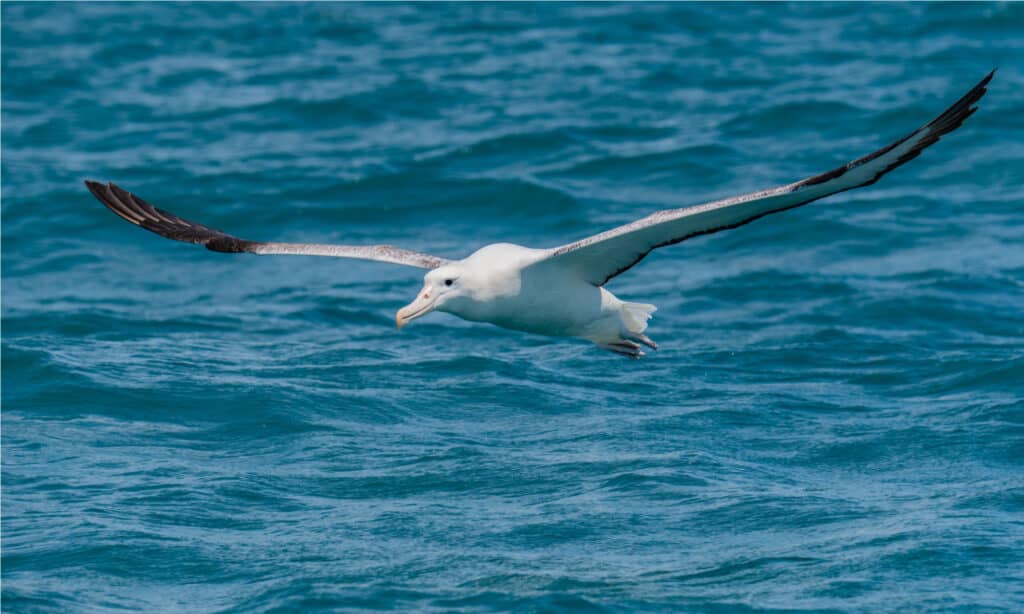
Albatrosses can live for several decades.
©Kerry Hargrove/Shutterstock.com
The largest flying bird on Earth, the albatross spends much of its life soaring over the open ocean. These impressive birds can go for months without landing — and some even go years without ever touching down on land! Like frigatebirds, albatrosses take advantage of the wind, locking their wings in place and gliding over the ocean waters for miles on end. Occasionally, they’ll alter the angle of their wings and adapt to the wind, allowing them to stay aloft without expending much energy.
5. Sea Otter (Enhydra lutris)

Sea otters have a long waterproof outer coat and a soft, fluffy undercoat.
©Brian Lasenby/Shutterstock.com
The sea otter is both the heaviest member of the weasel family and the smallest marine mammal on Earth. These adorable animals grow up to 5 feet long and weigh up to 100 pounds. However, unlike other marine mammals, sea otters don’t have blubber to keep them warm. Instead, they are covered with dense coats that are thicker than any other animal in the world — with up to 23,250 hairs per square inch! Sea otters keep their fur coats clean and pristine so that their hair can trap warm air and keep water out. These animals spend most of their lives in the sea, but they do occasionally sprawl out on rocky shores or beaches to rest, warm up, or enjoy a snack on land.
6. Polar Bear (Ursus maritimus)
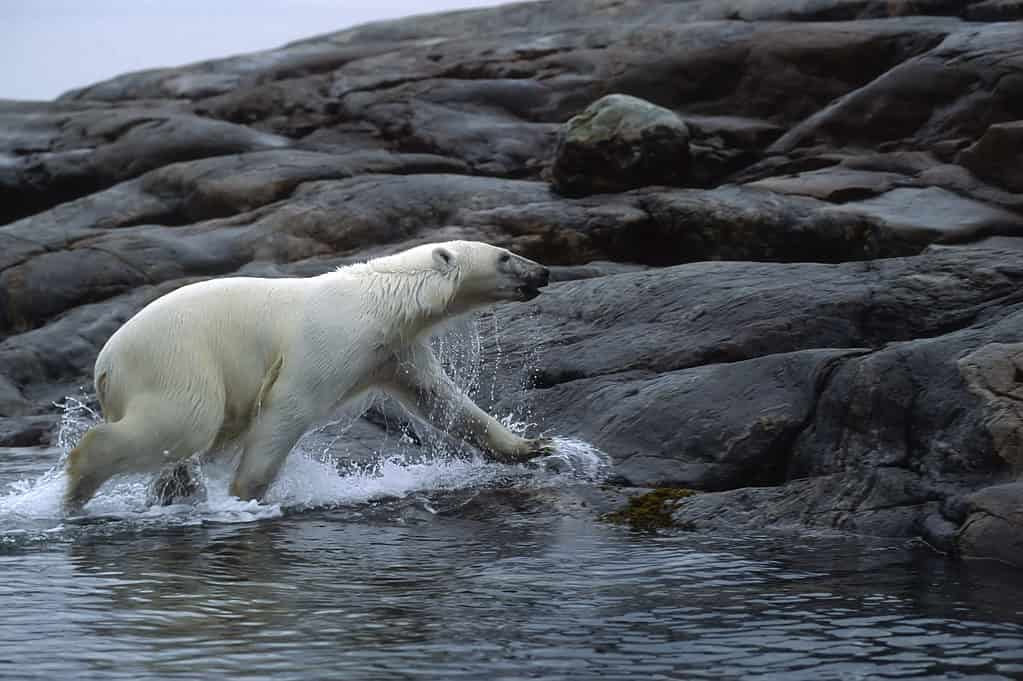
Polar bears can swim around six miles per hour through the water.
©iStock.com/JohnPitcher
An apex Arctic predator, the polar bear is a masterful hunter both on land and sea. These gigantic bears can weigh up to 1,300 pounds and are the largest land carnivores on Earth! They spend their lives in and around the ocean, living on sea ice and swimming through frigid waters. In fact, their scientific name (Ursus maritimus) is Latin and means “sea bear”. Polar bears stay warm in and out of the water with a thick, 4-inch layer of body fat and a dense, water-repellent fur coat.
7. Penguin (Spheniscidae)

Penguins’ wings are more like flippers.
©N8tureGrl/ via Getty Images
There are over 15 different species of penguins that live both on land and in the sea. They are unusual birds because they can’t fly, but they are extremely good swimmers. Penguins are versatile animals and spend around half their life on land and half at sea, living in extreme habitats from Antarctica to the Galápagos Islands. They have smooth feathers that help to trap warm air against their skin, providing insulation in cold water. Penguins may look a bit clumsy or awkward walking on land, but in the water, they are fast and agile. Gentoo penguins, for example, can swim up to 22 miles an hour!
8. Sea Turtle (Chelonioidea)

There are sea turtles living in every ocean on Earth except for in the polar regions.
©Shane Myers Photography/Shutterstock.com
Nearly all seven species of sea turtles are endangered or threatened with extinction. Although they spend the bulk of their lives out at sea, these marine turtles are air-breathing reptiles and must regularly return to the surface for air. In addition, sea turtles occasionally haul themselves onto beaches to bask in the sun or lay eggs. Female sea turtles dig holes in the sand using their enormous flippers to build nests and lay eggs.
9. Walrus (Odobenus rosmarus)
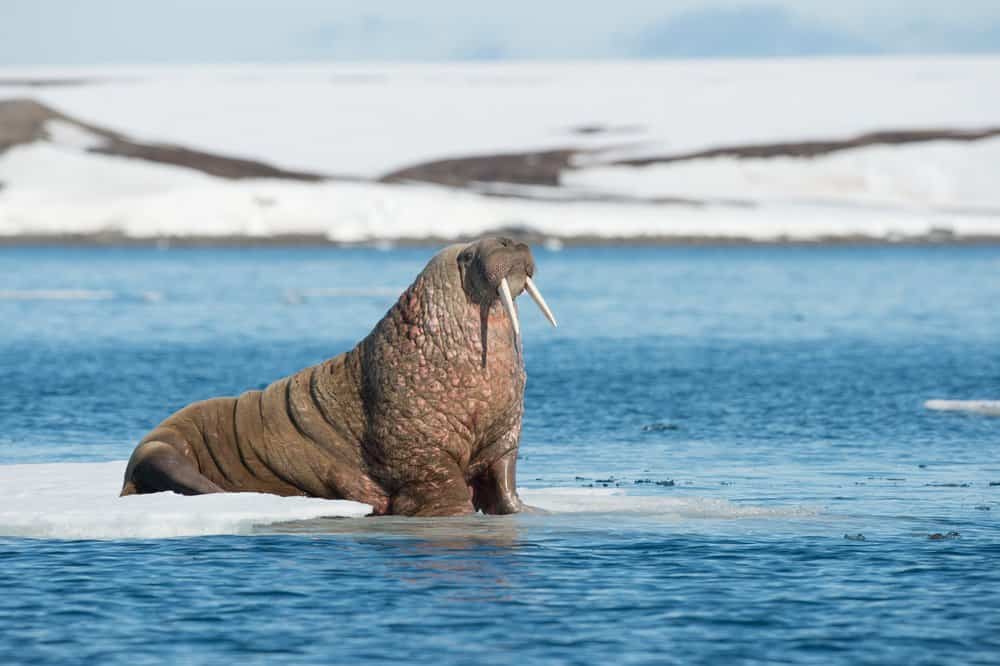
Walruses have long whiskers that help them detect food along the ocean floor.
©Inge Jansen/Shutterstock.com
The walrus is an enormous animal that lives on land and sea, and can weigh more than 4,400 pounds! These mammoth marine mammals spend their lives swimming in the water and resting, hunting, and breeding on sea ice. Both male and female walruses have elongated canine teeth — or tusks — that can grow over 3 feet long and weigh up to 12 pounds. Their bodies are insulated with blubber and a layer of fat that can be up to 6 inches thick.
10. Saltwater Crocodile (Crocodylus porosus)

Female saltwater crocodiles lay their eggs on land.
©Pius Rino Pungkiawan/Shutterstock.com
Capable of living in both saltwater and brackish (a mix of freshwater and saltwater) habitats, saltwater crocodiles are fierce reptiles with a big reputation. While most other crocodile species avoid people and are reasonably harmless, saltwater crocodiles can be very territorial and aggressive, and they have one of the strongest bites in the world. Saltwater crocodiles can grow longer than 23 feet and weigh over 2,200 pounds. They spend a lot of time in the water, but also rest and warm up on land in the sun.
11. Hippopotamus (Hippopotamus amphibius)
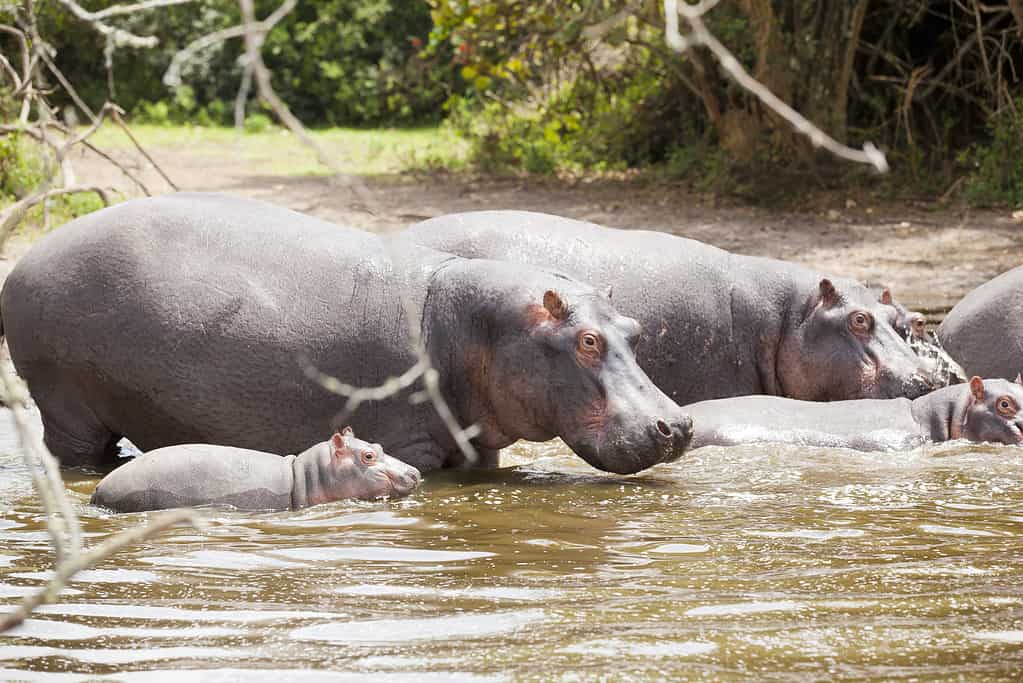
Hippos can grow up to 16.5 feet long.
©1001slide/iStock via Getty Images
Weighing up to over 8,000 pounds, the hippopotamus spends its days lounging in the water. At night, it climbs onto land and forages for food. Although hippos are herbivores and mostly eat grass, they are very formidable animals. They are territorial and can be aggressive to humans. However, hippos often also peacefully exist alongside other apex predators like Nile crocodiles and lions.
12. Seal (Pinnipedia)
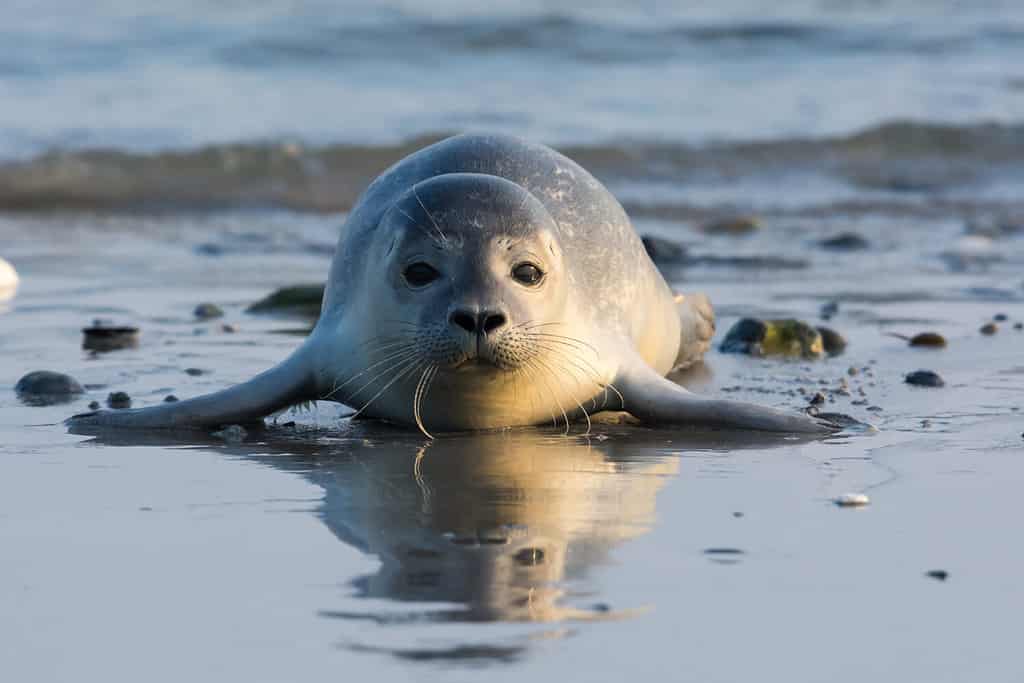
There are dozens of different seal species living all around the world.
©Iwona Fijol/Shutterstock.com
With strong flippers for both swimming and moving across land, seals are animals of both land and sea. These agile marine mammals have streamlined, torpedo-shaped bodies that easily cut through the water. Seals spend most of their days swimming through the water, but they also spend time on land to rest, soak up the sun, mate, give birth, and molt. Other times they seek refuge on land to escape marine predators like orcas and sharks. On land, seals use a movement called “galumphing”, propelling themselves forward with their flippers in a bouncing motion.
13. Sea Lion (Otariinae)
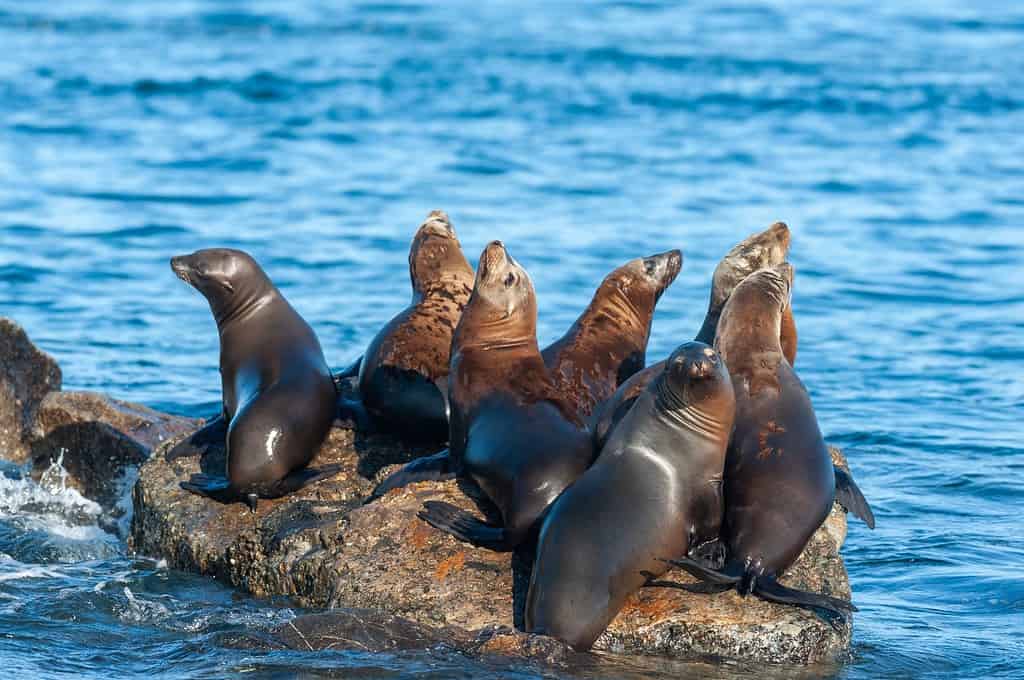
Sea lions can maneuver more easily on land than seals can.
©Goldilock Project/Shutterstock.com
Relatives of the seal, sea lions can swim at high speeds through ocean waters and use all four flippers to walk on land. They tend to hang out on and near beaches and rocky coastlines, relaxing in large groups along the edge of the water. Sea lions are very social animals and often live in groups with hundreds of individuals.
14. Marbled Rock Crab (Pachygrapsus marmoratus)
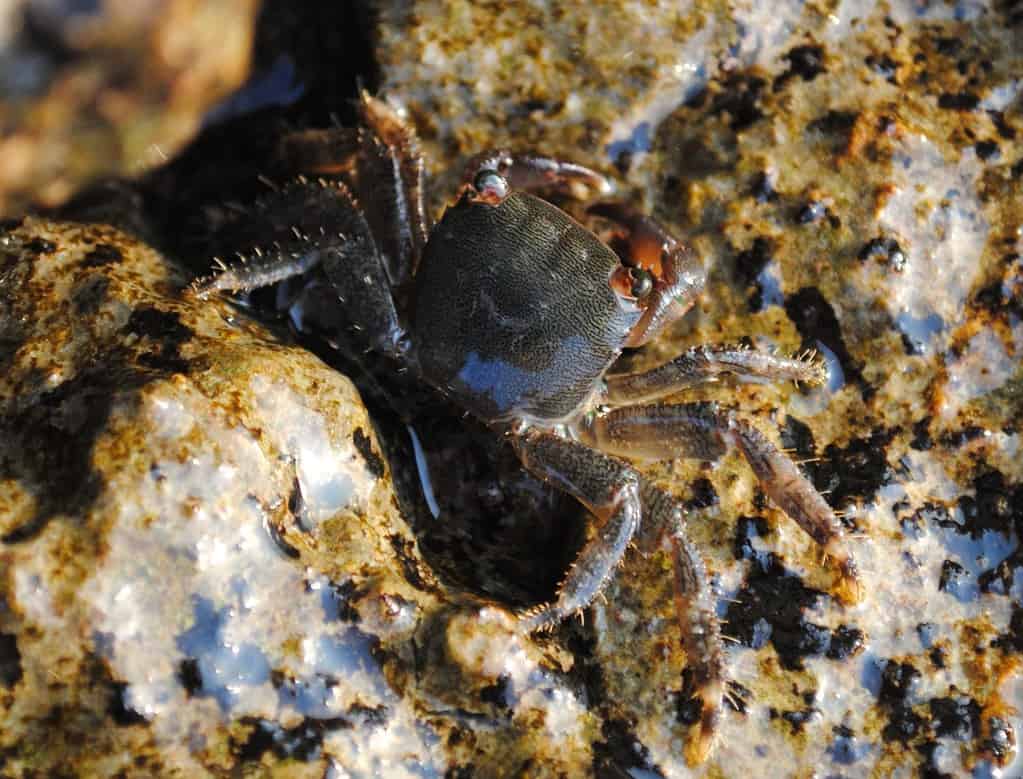
Marbled rock crabs live in intertidal zones, usually from the upper to middle shore.
©Igor Krasilov/Shutterstock.com
Found in parts of the Atlantic Ocean, Mediterranean Sea, and Black Sea, the marbled rock crab is only 1.4 inches long. Its name comes from the marbled pattern of its body, with dark violet brown and streaks of yellow. Marbled rock crabs are omnivores and eat prey like algae, limpets, mussels, and other crabs. They often spend time in the crevices or on rocks.
15. Intertidal Spider (Desis)

Desis bobmarleyi is an intertidal spider that lives on the shores of Australia.
©Robert Raven / CC BY 4.0, via Wikimedia Commons - License
If you think spiders can’t live in the ocean, think again! Several species of spiders have chosen a rather unusual place to live: in the ocean’s intertidal zone. At high tide, the intertidal zone is submerged underwater, but when the tide goes out, it’s exposed to the air. Despite having a build similar to land spiders, intertidal spiders can actually stay underwater for up to 24 hours at a time! Some species spin thick webs that trap air bubbles and create tiny underwater air pockets. Since there isn’t room for much oxygen, they also slow down their breathing.
16. Sea Kraits (Laticauda)
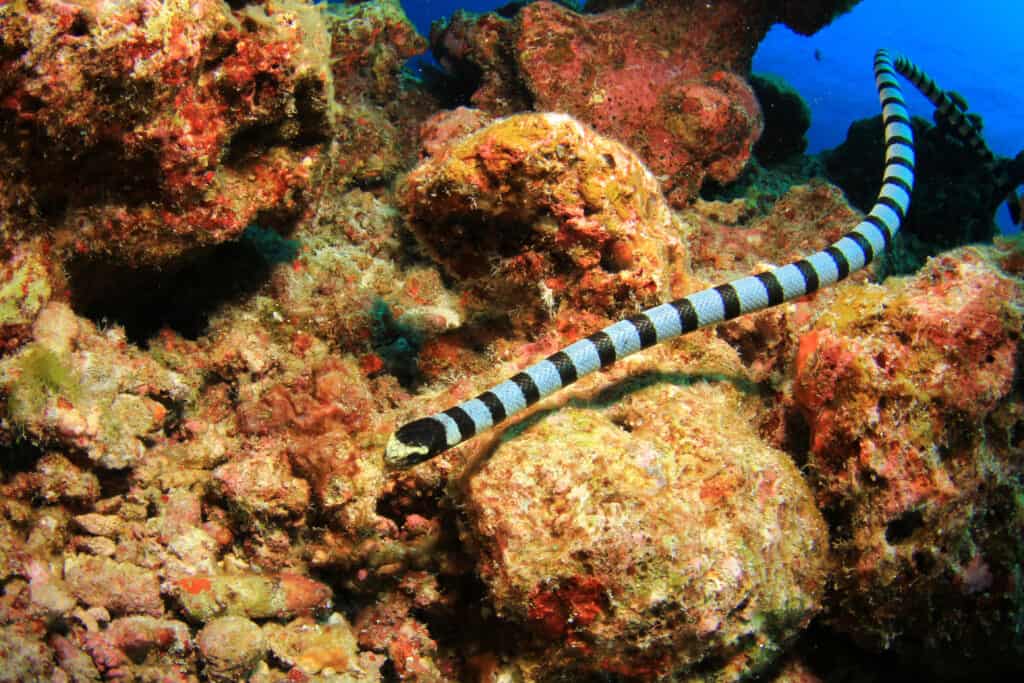
Sea kraits lay their eggs and digest their food on land.
©Rich Carey/Shutterstock.com
These semiaquatic sea snakes are venomous and live both on land and in the ocean. Sea kraits have flattened tails like paddles, which help propel them through the water. However, they also have wide ventral scales on their undersides that allow them to move across dry land as well. Sea kraits live in the southern and southeastern islands of Asia and are most active at night. They are reclusive, shy, and rarely bite. However, sea kraits have highly toxic venom and a bite from one requires immediate treatment.
17. Capybara (Hydrochoerus hydrochaeris)
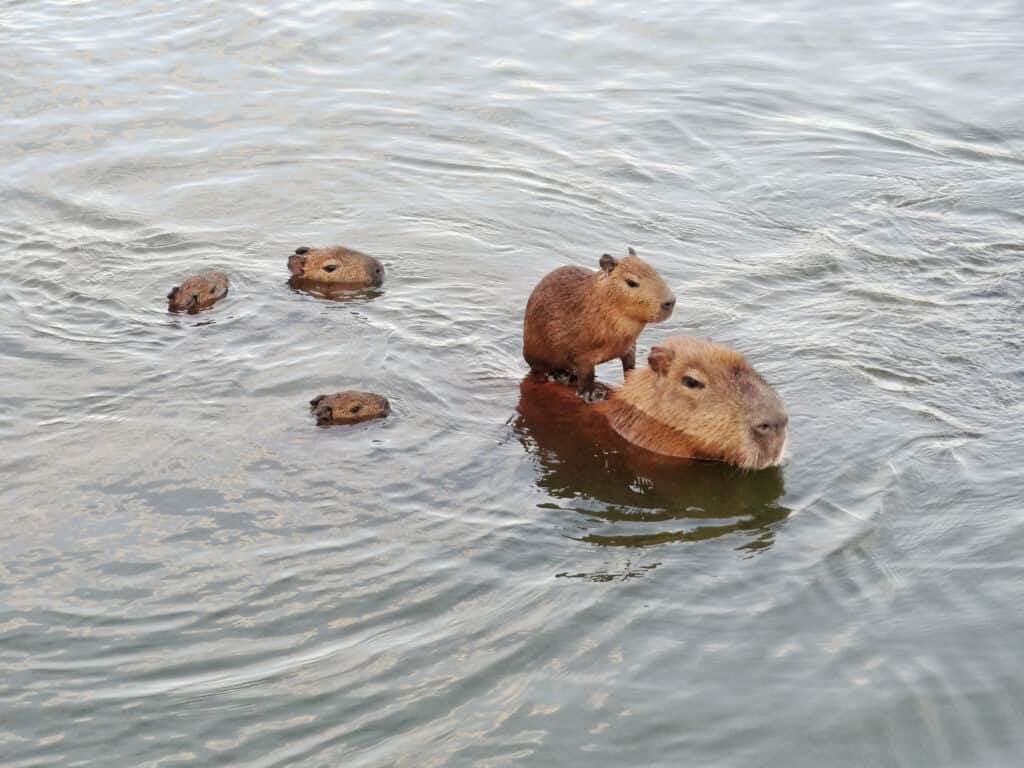
Capybaras are very social animals and live in large groups.
©iStock.com/Yuina Takase
Did you know that the largest rodent on Earth spends half its life in water? Native to South America, the capybara is a skilled swimmer that can hold its breath underwater for up to five minutes. Although these giant rodents typically live near bodies of freshwater, they can also be found near salty and brackish waters as well. Capybaras wallow in water to stay cool, and sometimes they even sleep in the water! Their scientific genus name, hydrochoerus, actually means “water pig”.
18. Cormorant (Phalacrocoracidae)

In some regions, cormorants are called “shags”.
©Kumud Parajuli/iStock via Getty Images
There are around 40 species of cormorants in the world. These incredible diving birds are fish-eaters and have extraordinary swimming and diving skills. Some cormorants can even dive as deep as 150 feet underwater! Although they typically live along the coast, they also make their homes near lakes and rivers as well. Cormorants have waterproof feathers as well as webbed feet and long, hooked bills for spearing fish and eels.
Additional Sources and Data Used to Compiled This List

©A-Z-Animals.com/A-Z Animals
A-Z Animals is committed to using the most up-to-date and accuracy research available.
- Ocean Conservancy. (2016). Marine Iguana Conservation [PDF]. Retrieved from https://oceanconservancy.org/wp-content/uploads/2022/05/09.23.2016.pdf
- Cornell University. (n.d.). Marine Iguanas. Retrieved from http://www.geo.cornell.edu/geology/GalapagosWWW/MarineIguanas.html
- Weimerskirch, H., Bishop, C., Jeanniard-du-Dot, T., Prudor, A., & Sachs, G. (2016). Frigate birds track atmospheric conditions over months-long transoceanic flights. Science, 353(6294), 74–78. https://doi.org/10.1126/science.aaf4374
- Weimerskirch, H., Gault, A., & Cherel, Y. (2016). Prey distribution and patchiness: factors in foraging success and efficiency of wandering albatrosses. Nature Communications, 7, Article 12468. https://www.nature.com/articles/ncomms12468
- Sachs, G., Traugott, J., Nesterova, A.P., Dell’Omo, G., Kümmeth, F., Heidrich, W., … Bonadonna, F. (2013). Flying at no mechanical energy cost: Disclosing the secret of wandering albatrosses. Nature Communications, 4, Article 2554. https://www.nature.com/articles/ncomms3554
The photo featured at the top of this post is © iStock.com/Maridav
Thank you for reading! Have some feedback for us? Contact the AZ Animals editorial team.







